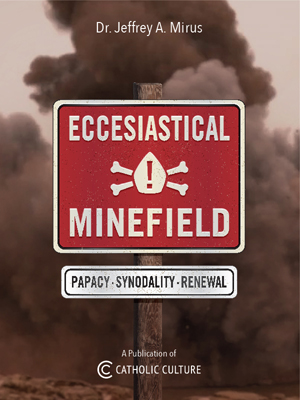A Closer Look at Centering Prayer
The Centering Prayer Movement has become very popular in Catholic circles today. But is it really Christian contemplation?
In my research on the New Age which I did for the past ten years, I found that it is not — this type of prayer is not recommended by Pope John Paul II, Pope Benedict XVI, The Catechism of the Catholic Church, or St. Teresa of Avila. There have also been warnings from Johnnette Benkovic on EWTN (Mother Angelica's Network). Johnnette has written a book called, The New Age Counterfeit, and devotes one chapter to the problems of Centering Prayer (CP). She identifies it as being the same as Transcendental Meditation (TM) which is tied to Hinduism.
What is Centering Prayer?
Centering prayer, as taught by Fr. Basil Pennington and Fr. Thomas Keating, is a method of prayer that is supposed to lead a person into contemplation. The person chooses a sacred word. He tries to ignore all thoughts and feelings, letting them go by as boats going down a stream. When the thoughts keep coming back, the person returns to the sacred word. The goal is to keep practicing until all thoughts and feelings disappear. Fr. Keating says in Open Mind, Open Heart, "All thoughts pass if you wait long enough."1 A person then reaches a state of pure consciousness or a mental void. The thinking process is suspended. This technique is supposed to put them into direct contact with God.
Fr. Thomas Keating is a monk, priest, and abbot and is the founder of the Centering Prayer movement. Fr. Basil Pennington is a Trappist monk. He has written over thirty books, some of which are on Centering Prayer. Some of the concepts in their books are similar to New Age beliefs and practices.
How do New Age Beliefs Compare to CP?
In CP, people are taught to use a prayer word or sacred word to empty the mind. (Fr. Keating says it is not a mantra; but if it is used to rid the mind of all thoughts and feelings, then it does the same thing as a mantra). The goal is to reach a mental void or pure consciousness in order to find God at the center. Pure consciousness is an altered level of consciousness (ALC). This is exactly what the Hindus and Buddhists do to reach god-consciousness or pure consciousness.
What is Similar Between CP and TM?
Johnnette Benkovic has interviewed people in her book who have done both CP and TM. They claim it is basically the same. The only difference would be that in TM the mantras are names of Hindu gods, and in CP the sacred word is usually Jesus, God, peace, or love. Let's look at the similarities:
- Both CP and TM use a 20-minute meditation.
- Both use a mantra to erase all thoughts.
- Both purport to give you more peace.
- Both try to get you to a mental void or ALC.
- Both have the goal of finding a god-center.
Using mantras and reaching a mental void are New Age, not Catholic. In fact, reaching a mental void is described in the Catechism as an erroneous notion of prayer (#2726).
When Does CP Become Non-Christian?
In the beginning stages of CP, the one who prays is still ignoring thoughts as they float by. If they are still thinking of Jesus or heavenly things, they are still in Christian prayer. They cross the line when they get to the point where they bypass all thoughts and feelings till there are no thoughts at all. Fr. Thomas Keating says in his book, Open Mind, Open Heart, "As you go down deeper, you may reach a place where the sacred word disappears altogether and there are no thoughts. This is often experienced as a suspension of consciousness, a space."2 When a person is able to do this, they have crossed the line. He is no longer practicing Christian prayer. Fr. Keating even says, "The method consists of letting go of every thought during the time of prayer, even the most devout thoughts."3 (In Christian prayer, devout thoughts are important and desirable.) He also tells his followers to let all feelings go. To do this, one would have to let go of any sentiments of love toward Jesus, the Father, or the Holy Spirit.
What Does Pope John Paul II Say About CP?
In Cardinal Ratzinger's booklet, Letter to the Bishops of the Catholic Church on Some Aspects of Christian Meditation, he quotes the Pope. On p. 34, footnote 12, he writes "Pope John Paul II has pointed out to the whole Church the example and doctrine of St. Teresa of Avila . . . In a homily given on November 1, 1982, he said that the call of St. Teresa of Jesus advocating a prayer completely centered on Christ 'is valid even in our day, against some methods of prayer which are not inspired by the gospel and which in practice tend to set Christ aside in preference for a mental void which makes no sense in Christianity.'" [See Homilia Abulae habita in honorem Sanctae Teresiae: AAS 75 (1983) 256-257].
What Does St. Teresa of Avila Say?
Throughout their books, Fr. Keating and Fr. Pennington mention St. Teresa of Avila, implying that she is an advocate of their prayer techniques. However, her teachings on prayer are the opposite of what they are teaching. She says that contemplation is a gift from God, and no technique can make it happen. She said that entering into the prayer of quiet or that of union whenever she wanted it "was out of the question."4 She also said in her book, Interior Mansion, "For it to be prayer at all, the mind must take a part in it."5 Cardinal Ratzinger, in his booklet, also quoted St. Teresa as saying that the separation of the mystery of Christ from Christian meditation is always a form of "betrayal."6 St. Teresa advised her nuns to meditate or think about the Passion of Christ to prepare for contemplation.
Has Pope Benedict XVI said Anything?
In 1989, when he directed the Congregation for the Doctrine of the Faith, he put out a document called "Letter to the Bishops of the Catholic Church on Some Aspects of Christian Meditation." The document states, "With the present diffusion of Eastern methods of meditation in the Christian world and in ecclesial communities, we find ourselves faced with a pointed renewal of attempt, which is not free from dangers and errors, to fuse Christian meditation with that which is non-Christian." He goes on to say, "Still others do not hesitate to place that absolute without image or concepts, which is proper to Buddhist theory, on the same level as the majesty of God revealed in Christ."7 He says they abandon the Triune God, "in favor of an immersion in the indeterminate abyss of the divinity." Then he says mixing Christian meditation with Eastern techniques can lead to syncretism (the mixing of religions).
What are ALCs and What are the Dangers?
Fr. Finbarr Flanagan writes in an article "TM's founder, the Maharashi Yogi, claims that the regular practice of TM leads beyond the ordinary experience of waking, sleeping, and dreaming to a fourth state of consciousness called "simple awareness." Constant practice leads to cosmic consciousness, then god-consciousness, and finally "unity consciousness."8 People who have reached these altered levels of consciousness (ALC's) describe them as a pleasant trance-like state. Cardinal Ratzinger says, in regard to ALC's, "Some physical exercises automatically produce a feeling of quiet and relaxation, pleasing sensations, perhaps even phenomena of light and warmth, which resemble spiritual well-being. To take such feelings for the authentic consolations of the Holy Spirit would be a totally erroneous way of conceiving the spiritual life. Giving them a symbolic significance typical of the mystical experience, when the moral condition of the person does not correspond to such experience, would represent a kind of mental schizophrenia which could also lead to psychic disturbance and, at times, to moral deviations."9
In Fr. Keating's book, Open Mind, Open Heart, p. 120, one of his followers commented that he had a hard time coming out of an ALC during Mass and could not concentrate. Fr. Keating told him, "That is a nice problem to have." Fr. Amorth, who is the Vatican exorcist, says "Yoga, Zen, and TM are unacceptable to Christians. Often these apparently innocent practices can bring about hallucinations and schizophrenic conditions."10
Has the Vatican said Anything?
Yes. The Vatican recently released the document called "Jesus Christ, the Bearer of the Water of Life: A Christian Reflection on the New Age." It specifically identifies the following as New Age: Zen Buddhism, Hinduism, Yoga, Enneagram, Wicca, the Higher Self, the True Self, ALC's, the "god within," and TM. The Vatican document states that these new age beliefs and practices cannot be accepted by those who are faithful to Christ and his Church.
References Cited
- T. Keating, Open Mind, Open Heart, (Amity, N.Y.: Amity House, 1986), p.97.
- T. Keating, Open Mind, Open Heart, p.114.
- Ibid., p. 35.
- J. Benkovic, The New Age Counterfeit, p. 23-24, quoting from The Life from the Collected Works of St. Teresa, Vol. 1, Washington Province of Discalced Carmelites, p.1976.
- Peter Thomas Rohrbach, Conversation with Christ, by St. Teresa of Avila (Rockford, IL: Tan Publishing Co.) p.78, quoting St. Teresa of Avila, Interior Mansion, P. I. i.
- Cardinal J. Ratzinger, Letter to the Bishops of the Catholic Church on Some Aspects of Christian Meditation, Oct. 15, 1989 (Text from English version published by St. Paul Books and Media, 50 St. Paul's Ave., Boston, MA 02130) p.34.
- Ibid., p. 16.
- F. Flanagan, "Centering Prayer: Transcendental Meditation for the Christian Market", p. 2.
- Cardinal J. Ratzinger, Letter to the Bishops of the Catholic Church on Some Aspects of Meditation, p. 28-29.
- G. Amorth, An Exorcist Tells His Story, (San Francisco, CA.: Ignatius Press), 1999.
Mrs. Margaret A. Feaster is a housewife and mother of three children. She and her husband live in Lilburn, Ga. She is on the leadership committee for the Catholic Charismatic Renewal in Atlanta, and is in formation for the Discalced Carmelite Secular Order. She belongs to a Rosary Cenacle, and heads up the parish telephone prayer line. She is also a writer for her parish newsletter.
© Ignatius Press Excerpted and adapted from CatholicCulture.org For more information see original
This item 8912 digitally provided courtesy of CatholicCulture.org






